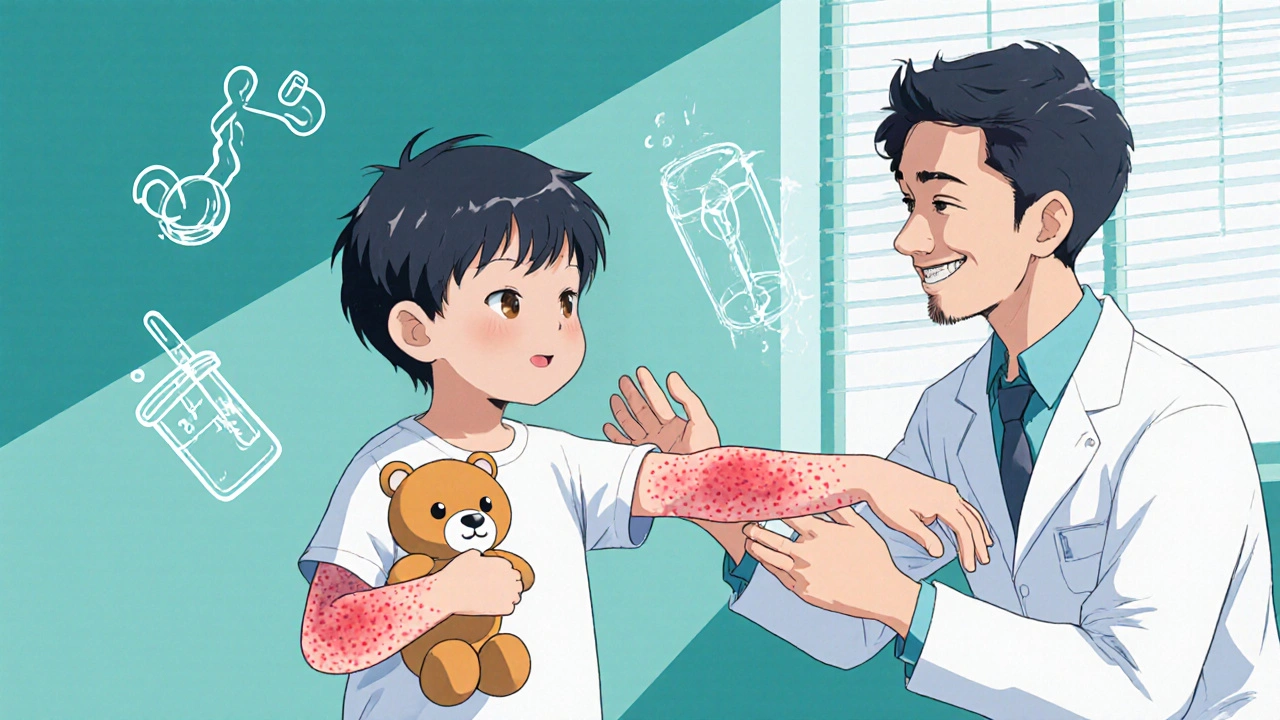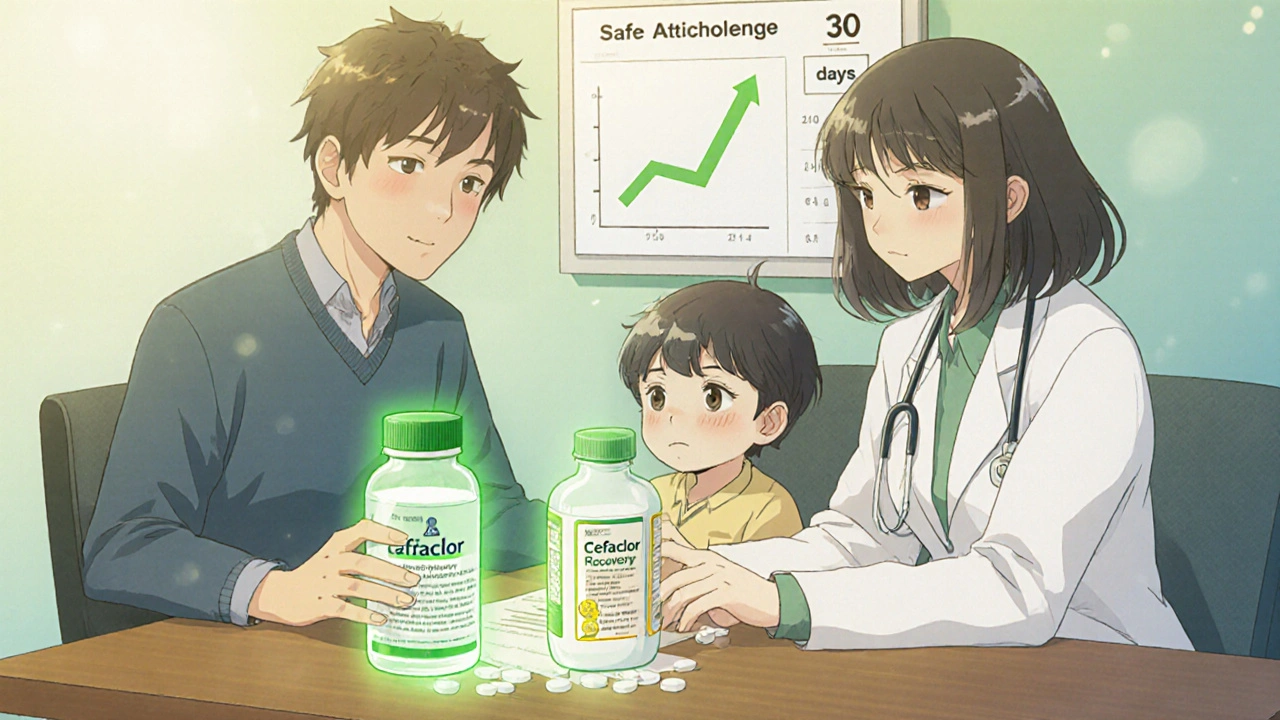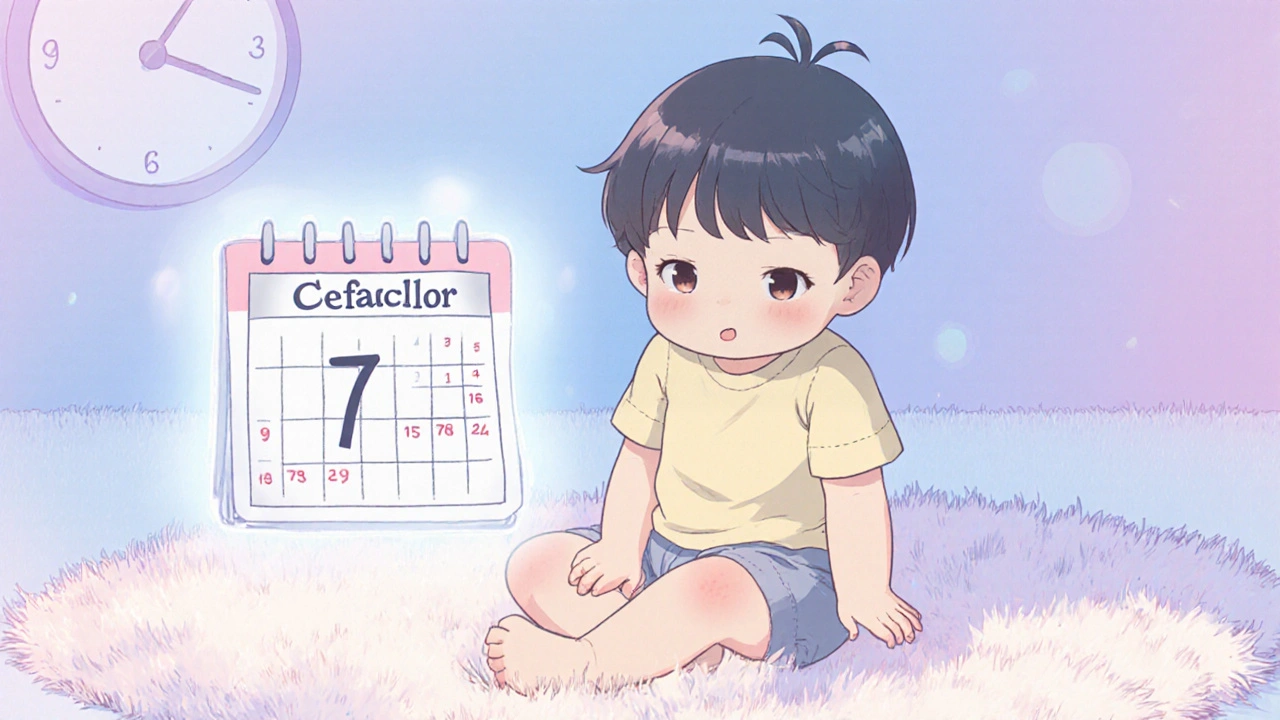SSLR Diagnostic Calculator
This tool helps clinicians evaluate the likelihood of Serum Sickness-Like Reaction (SSLR) based on key clinical features. SSLR is a delayed hypersensitivity reaction to antibiotics, typically appearing 1-21 days after exposure.
When a patient develops a Serum Sickness‑Like Reaction (SSLR) is a delayed, immune‑mediated hypersensitivity syndrome that typically appears 1-21 days after exposure to certain antibiotics, clinicians must act fast to avoid unnecessary lifelong drug restrictions. Understanding the Serum Sickness‑Like Reaction helps you separate it from true serum sickness, viral rashes, or a classic penicillin allergy.
What Is SSLR?
SSLR first emerged in pediatric case series in the 1980s. Unlike classic serum sickness, which is a Type III immune‑complex disease, SSLR shows no circulating immune complexes, normal complement levels, and a milder, self‑limited course. Current consensus (UpToDate 2023, DynaMed 2024) defines SSLR as a delayed hypersensitivity reaction that peaks around day 7-10 after the offending drug.
How SSLR Differs From True Serum Sickness
| Feature | SSLR | True serum sickness |
|---|---|---|
| Typical trigger | Cefaclor or other β‑lactam antibiotics | Antiserum, monoclonal antibodies, antivenoms |
| Onset after exposure | 1-21 days (median 7 days) | 5-14 days |
| Fever | 85 % (usually 38-39 °C) | 98 % |
| Renal involvement | None (normal urinalysis) | 15‑25 % develop proteinuria |
| Immune complexes | Absent; normal C3/C4 | Present; low complement |
| Resolution | 3‑7 days after drug stop (92 % cases) | ≈14 days, may need steroids |
Who Is Most Affected?
Epidemiology points to children as the primary group. Cincinnati Children’s Hospital (2022) reports that 78 % of SSLR cases occur in kids aged 6 months to 6 years. Incidence is roughly 0.2-0.4 per 1,000 antibiotic courses, but cefaclor carries a higher risk of 0.6-1.2 % in children under five.
Typical Clinical Picture
The classic triad appears in >90 % of patients:
- Urticarial rash: migratory, intensely pruritic wheals that move every few hours.
- Fever: 38‑39 °C, often accompanying the rash.
- Arthralgia or symmetric arthritis of knees, wrists, ankles.
Additional findings may include lymphadenopathy (45 %), malaise (68 %), and myalgia (30 %). Notably, there is no vasculitis, no nephritis, and no carditis-features that help separate SSLR from acute rheumatic fever and true serum sickness.

Diagnostic Work‑up
Because SSLR lacks a single lab marker, diagnosis is clinical, supported by exclusion:
- Confirm drug exposure 1-21 days prior.
- Laboratory panel: CBC (often normal), ESR/CRP (mildly elevated), normal complement (C3/C4), negative cryoglobulins, normal urinalysis.
- Rule out viral exanthems (e.g., serology for EBV, parvovirus B19) and acute rheumatic fever (ASO titers, cardiac exam).
- If uncertainty persists, skin biopsy shows perivascular lymphocytic infiltrate without immune‑complex deposition.
Remember, Complement levels remain within reference ranges, a stark contrast to true serum sickness where C3/C4 drop.
Management Strategies
The cornerstone is immediate cessation of the suspected antibiotic-ideally within 24 hours of symptom onset (DynaMed). Symptomatic therapy follows a step‑wise plan:
- Second‑generation antihistamine (e.g., cetirizine 0.25 mg/kg every 12 h) for pruritus.
- NSAID such as ibuprofen 10 mg/kg every 8 h for joint pain.
- Oral prednisone 1 mg/kg/day, tapered over 7-10 days, reserved for severe functional limitation or persistent fever.
Most children improve within 48 hours after stopping the drug; full resolution occurs by day 5 in the majority.
Future Antibiotic Use & Rechallenge
AA AAI 2022 practice parameters emphasize that SSLR does not mandate avoidance of the entire β‑lactam class. Only the culprit (e.g., Cefaclor) should be avoided. Studies show an 89 % tolerance rate for alternative cephalosporins and a 92 % tolerance rate for non‑beta‑lactam antibiotics after a supervised oral challenge 6-36 months later.
Rechallenge protocol (Cincinnati Children’s 2023):
- Confirm complete symptom resolution for at least 30 days.
- Obtain baseline labs (CBC, renal function).
- Administer graded doses of the test drug under observation.
- Monitor for 2 hours post‑dose; treat any emergent rash with antihistamine.

Common Pitfalls & Clinical Impact
Mislabeling SSLR as a true penicillin allergy leads to:
- Unnecessary use of vancomycin or carbapenems in 42 % of cases.
- Annual excess healthcare spending of $187 million in the U.S. (American Journal of Managed Care 2022).
- Increased antimicrobial resistance.
Electronic health records often record SSLR under “allergy”-a 74 % error rate (Journal of Allergy & Clinical Immunology In Practice 2022). Involving an allergy specialist early reduces this mistake by 68 %.
Emerging Research & Biomarkers
Genetic studies point to a CYP2C9*3 polymorphism in 72 % of SSLR patients, suggesting altered metabolism of cefaclor metabolites. The PREDICT study (2023‑2026) is validating a urine metabolite panel with 94 % sensitivity for distinguishing SSLR from IgE‑mediated allergy.
Regulatory bodies are responding: the FDA draft guidance (2023) now requires drug labels to mention SSLR as a distinct adverse event. The 2024 International Consensus Document (Allergy journal) gave SSLR its own ICD‑11 code (RA43.1), simplifying coding and billing.
Quick Takeaways
- SSLR appears 1‑21 days after certain antibiotics, most often cefaclor.
- Key signs: migratory urticarial rash, fever, symmetric arthralgia.
- Laboratories are usually normal; complement levels stay unchanged.
- Stop the drug, treat symptoms, and expect resolution within a week.
- Only the offending drug needs avoidance; other β‑lactams are generally safe after proper rechallenge.
Frequently Asked Questions
How soon after taking an antibiotic can SSLR develop?
SSLR typically shows up 7-10 days after exposure, but the window ranges from 1 to 21 days.
Is SSLR the same as a penicillin allergy?
No. SSLR is a delayed hypersensitivity reaction without IgE involvement. It does not preclude future use of other penicillins or cephalosporins after a supervised challenge.
What labs help confirm SSLR?
CBC, ESR/CRP may be mildly abnormal, but complement (C3/C4) stays normal, urinalysis is clean, and immune complexes are absent. These findings differentiate SSLR from true serum sickness.
Can adults get SSLR?
Yes, though it is far less common. Adults account for roughly 22 % of reported cases, often linked to the same β‑lactam antibiotics.
When is steroid therapy indicated?
If fever persists beyond 48 hours, joint pain limits daily activities, or rash is extensive and unresponsive to antihistamines, a short course of oral prednisone (1 mg/kg tapered over 7‑10 days) is reasonable.


Barna Buxbaum
October 26, 2025 AT 19:33The key takeaway is that SSLR typically shows up within a week after the offending β‑lactam, most often cefaclor. It presents with a pruritic urticarial rash, fever, and symmetric arthralgia, while complement levels remain normal. Labs are usually unremarkable apart from mild ESR/CRP elevation, which helps separate it from true serum sickness. Stopping the drug within 24 hours usually leads to improvement within 48 hours, and full resolution is expected by day 5. For symptomatic relief, a second‑generation antihistamine and ibuprofen are sufficient for most cases. Steroids are reserved for severe or persistent symptoms, typically a short taper of prednisone 1 mg/kg. The literature shows an 89 % tolerance rate for alternative cephalosporins after a supervised challenge, so the entire β‑lactam class does not need to be avoided. Rechallenge protocols involve graded dosing under observation, with a 2‑hour monitoring window. Awareness of this entity prevents unnecessary broad‑spectrum antibiotic use and the associated cost burden.
Miracle Zona Ikhlas
October 26, 2025 AT 20:06Thanks for laying out the differences; this will help clinicians avoid over‑labeling.
Chris L
October 26, 2025 AT 20:40It's encouraging that most kids recover within five days once the drug is stopped, which means we can reassure families early and prevent a cascade of unnecessary investigations.
Abbey Travis
October 26, 2025 AT 21:05I agree, and adding a quick checklist for clinicians can streamline the work‑up: confirm exposure window, check normal complement, and rule out viral exanthems.
Gary Campbell
October 26, 2025 AT 21:46What most people don’t realize is that the FDA’s new label warning on SSLR is really a smokescreen. They want us to think every rash after antibiotics is a serious liability, pushing us toward ever‑broader drugs and higher profits for pharma.
Barna Buxbaum
October 26, 2025 AT 22:11While the regulatory concerns are real, the data behind the SSLR label are based on solid pharmacovigilance studies. The distinction between SSLR and true IgE‑mediated allergy is well‑documented, and the guidance helps avoid unnecessary avoidance of the whole β‑lactam class.
Alisha Cervone
October 26, 2025 AT 22:45Meh, more hype than help.
Diana Jones
October 26, 2025 AT 23:18Wow, another masterclass in antibiotic etiquette – because clearly we’ve never seen a rash before.
asha aurell
October 26, 2025 AT 23:51The article overcomplicates a fairly straightforward clinical picture.
naoki doe
October 27, 2025 AT 00:16While you dismiss the complexity, the data on CYP2C9*3 can’t be ignored because it shapes metabolism, which in turn influences reaction severity, and clinicians should integrate pharmacogenomics into their assessment.